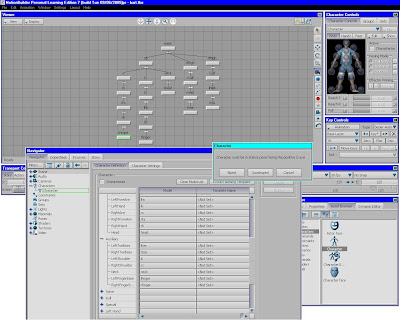This project is about creating controls for user-supplied meshes dynamically. This process ("rigging") covers various aspects of character setup, such as creating animation controls for the skeleton (which is to be created by the computer with inputs from the user regarding joint designations), character extensions, soft/rigid bodies and secondary motions (in particular determining various keys to control them; set-driven keys as mentioned can be used to control multiple attributes, exactly how is to be determined later). While a working end-product would be expected, the larger aim of this project would be to develop a practical framework/methodology which can be applied or modified for other similarly based projects. The process by which we can achieve knowledge-driven character rigging is therefore more important.
Because this project is oriented towards creating a tool for beginners (some of the papers ive come across are similar in this aspect), it is expected that the rigs created be generic enough to be applied to other meshes with some variations made. The process should be highly modularised as well. This makes it easy to spot and reduce errors and unwanted influences. There should also be a learning mechanism in place that can detect "dangerous" parameters from user inputs and come up with a best learned solution. This is to prevent users from committing errors (especially since it is aimed at helping novices). Lastly an intuitive HCI is to be developed. Current offerings in the market have highly unintuitive HCI due to their extremely complex functionalities. For now the focus would be on bipeds.
I found that MotionBuilder from Alias is rather similar to what we wish to achieve, but it requires the skeleton as an input from the user,which it then rigs according to user preferences.

User input parameters

Rig is created with user inputs
There is existing research on generating skeletons generic enough to fit different meshes. They only work on bipeds, however, and the mesh must have a certain general shape or the rigging would fail. DreamWorks discussed how difficult it is to dynamically "shift" a rigged model from a biped to a quadraped with their character Puss-in-Boots.
RELATED WORKS
Automatic Rigging and Animation of 3D Characters by Ilya Baran and Jovan Popovic
Morphable Model of Quadraped Skeletons for Animating 3D Animals by
Lionel Reveret, Laurent Favreau, Christine Depraz, Marie-Paule Cani
The Chronicles of Narnia: The Lion, The Crowds and Rhythm and Hues from Rhythm and Hues Studios
Art-Directed Technology: Anatomy of a Shrek2 Sequence from DreamWorks 2004
Synthesizing realistic spine motion using traditional rig controllers by Jabbar Raisani
Physically Based Rigging for Deformable Characters by
Steve Capell, Matthew Burkhart, Brian Curless, Tom Duchamp, and Zoran Popovi´c
Interactive Skeleton Extraction for 3D Animation using Geodesic Distances by
Takuya Oda Yuichi Itoh Wataru Nakai Katsuhiro Nomura Yoshifumi Kitamura Fumio Kishino
Misc
Style-Based Inverse Kinematics by Keith Grochow1 Steven L. Martin1 Aaron Hertzmann2 Zoran Popovi´c1
Rigging a Horse and Rider: Simulating The Predictable and Repetitive Movement Of The Rider
by Jennifer Lynn Kuhnel
Grove: A Production-Optimised Foliage Generator for The Lord of The Rings: The Two Towers"
by Matt Aitken Martin Preston
No comments:
Post a Comment